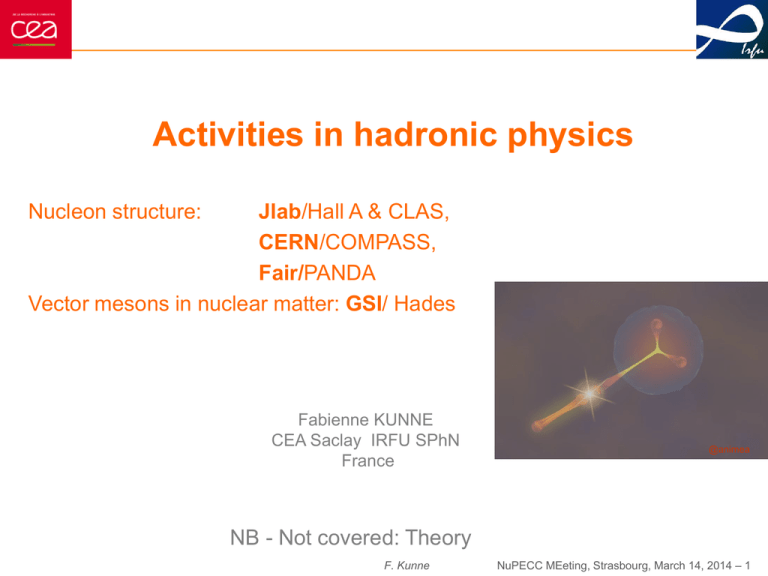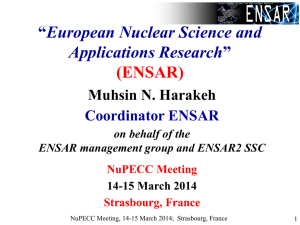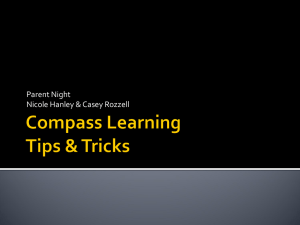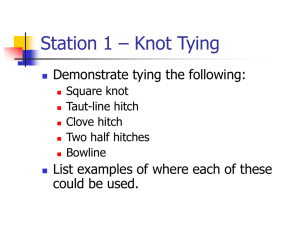Fabienne Kunne
advertisement

Activities in hadronic physics Nucleon structure: Jlab/Hall A & CLAS, CERN/COMPASS, Fair/PANDA Vector mesons in nuclear matter: GSI/ Hades Fabienne KUNNE CEA Saclay IRFU SPhN France @animea NB - Not covered: Theory F. Kunne NuPECC MEeting, Strasbourg, March 14, 2014 – 1 Questions - How hadrons are formed and interact from QCD degrees of freedom ? Lattice QCD calculations - How does the proton spin originates at the microscopic level ? Measuring pertinent spin sum rules - How does confinement manifests itself in the structure of hadrons ? Space and momentum distributions of quarks and gluons - GPDs, Generalized Parton Distributions, DVCS Deep Virtual Compton Scattering - TMDs, Transverse Momentum Dependent distributions. SIDIS or Polarized Drell-Yan. - TDAs F. Kunne NuPECC MEeting, Strasbourg, March 14, 2014 – 2 Confinement, asymtotic freedom, factorisation à short range, high energy à long range, low energy @animea @animea Degrees of freedom: quarks and gluons Bound states: hadrons A unique laboratory for the study of QCD Perturbation theory The observed states are not the degrees of freedom of the theory, but … … factorization allows us to relate the observed states to the degrees of freedom in some ’’hard’’ processes. F. Kunne 2 NuPECC MEeting, Strasbourg, March 14, 2014 – 3 Methods -1. Quark and gluon spin distributions - Probe quarks or gluons in nucleon with lepton beams - Measure spin asymmetry : polarized beam and target quarks Deep inelastic scattering gluons Photon-gluon fusion: ggqq h x : nucleon momentum Q2 fraction carried by quark : 4-momentum transfered (resolution ~ 1/Q) → →→ ← Dq = q - q quark polarization DS : sum over u, d, s flavours DG • Access quark and gluon spin contribution to the nucleon • Compare to lattice QCD F. Kunne NuPECC MEeting, Strasbourg, March 14, 2014 – 4 Methods - 2. Generalized parton distributions For the first time, study correlation between longitudinal quark momentum and quark transverse position in nucleon. Deep virtual Compton scattering (DVCS) A process which interferes with Bethe-Heitler x, x : quark momentum fraction t : transfer to proton H(x,x,t) : Gen. Parton distribution Can be studied in the interference regime (Jlab and COMPASS) and at high energy where BH smaller (COMPASS) - Theoretical concept: 1996 - First dedicated experiment 2004 JLab (IRFU/SPhN) - One of the major goals of future programmes:JLab 12 GeV, COMPASS, EIC GPD extraction from data 2D Fourier T. 3D picture of the nucleon Compare first moments to lattice QCD F. Kunne NuPECC MEeting, Strasbourg, March 14, 2014 – 5 Actors on two sites: CERN/COMPASS and JLab Hall A COMPASS CLAS International Collaboration , ~220 members International Collaborations, ~200 members Responsibilities in the collaboration: Co- spokesperson of the collaboration, analysis coordinator, technical coordinator, members of drafting commitees and group leader board Responsibilities in the collaboration: Spokesperson of expts., member of the steering committee, member of user board Leadership : Longitudinal Spin program, DVCS Add. fundings: FP6, FP7, ANR SPLAM, ANR PARTONS, P2I, NSF Leadership : DVCS, phenomenology Add. fundings: FP6, FP7, ANR,GPD@CLAS12, ANR SPLAM, ANR PARTONS, P2I(O), DOE F. Kunne NuPECC MEeting, Strasbourg, March 14, 2014 – 6 Main results from COMPASS Instrumentation - Recoil proton detector - Large MPGD Micromegas - Hybrid (GEM-MM) - Large drift chambers pixelized - ECAL calorimeter monitoring - RICH electronics - Instrum of superconducting magnet Physics results nucleon spin ½ = ½ DS + DG + Lq + Lg Quark polarization per flavour Hybrid (GEM-Micromegas) pixellized Gluon polarization • COMPASS Distribution de polarisation des gluons 2=3 (GeV/c)2de Distributions Q polarisation des quarks Well measured. Some puzzle with Ds (strange quark polarization). F. Kunne DG/G slightly >0 for xg~ 0.1. Full integral not well constrained 6 NuPECC MEeting, Strasbourg, March 14, 2014 – 7 COMPASS results cont’d World data on spin structure functions g1 proton deuteron Data at high Q2 and low x + COMPASS NLO QCD fit of world data 0.27< DS < 0.32, in agreement with Lattice QCD, Largest uncertainty comes from functional DS (x) & DG(x) F. Kunne shapes NuPECC MEeting, Strasbourg, March 14, 2014 – 8 Main results from Jlab experiments Instrumentation CLAS Superconducting magnet for active shielding Monitoring for DVCS calorimeter Micromegas for CLAS12 (next) DVCS magnet DVCS calorimeter Experiments DVCS expts: H, ~ H (spokesperson) meson production Important results t exp .(spokesperson) Scattering on free quarks at low energy Extensive measurements in a wide kinamatical range Precise DVCS data in a wide kinematical range Study production mechanism of p°, r et w Hall A Scale invariance F. Kunne CLAS NuPECC MEeting, Strasbourg, March 14, 2014 – 9 What’s next? COMPASS Jlab: Hall A and CLAS12 Muon and pion beams 160 – 200 GeV GeV Intermediate luminosity Study gluon and sea quarks Electron beam 11GeV High luminosity Study valence quarks Complementary approach in method and kinematics Platform for phenomenology PARTO N S (ANR) A common goal: mapping of 3D nucleon structure F. Kunne NuPECC MEeting, Strasbourg, March 14, 2014 – 10 JLab12 DVCS program - Short & mid term plans Accessing GPD H Impact of projected data CLAS12 CLAS Instrumentation : Micromegas trackers Innovations : Cylindrical MM high transverse field Start : 2015 Duration: 200 days of beam Responsibilities : spokesperson, run group coordination Expected results: 3D proton picture in valence region IPNO (MG) F. Kunne NuPECC MEeting, Strasbourg, March 14, 2014 – 11 COMPASS DVCS and Spin - Short & mid term plans Recoil proton detector HERA: gluons ? ’= 0.8 transverse Sea quark distribution 4m scintillators, st=300ps COMPASS-II Strange quark distribution Hybrid Micromegas-GEM pixel Instrumentation : Recoil proton detector Hybrid MM-GEM pixelized Innovations : 4m scintillators st=300ps Large size hybrid MM-GEM COMPASS-II DVCS : 2012, 2016-2017 Polarized Drell-Yan: 2014-2015 Responsibilities: leader of DVCS program in COMPASS Expected results: 3D proton picture in sea region TMDs + strange quark Fragmentation Functions, PDF and spin. F. Kunne NuPECC MEeting, Strasbourg, March 14, 2014 – 12 Long term: some study for future EIC collider Optimized energy/ detector for electron ion collisions (DOE-BNL-JLab, 500M$, 2025?) R&D proposal MIT-Temple-Irfu: Central tracker EIC committee : « well received and fully funded (150 k$) » French participation : Science case, phenomenology, instrumentation Financements : FP7, DOE F. Kunne NuPECC MEeting, Strasbourg, March 14, 2014 – 13 HADES at GSI (Darmstadt) Study fundamental properties of the strong interaction: vector meson (ρ,ω) studies in nuclear matter pp at 3.5 GeV and elementary collisions Dilepton production Reference for medium effects Selective study of dielectron sources via exclusive channels Electromagnetic structure of baryons (link with PANDA) p0 h r w IPNO technical contribution: -6 drift chambers (external tracking plane) -LH2 target Crucial ingredient for the description: production of ρ meson via baryonic resonances IPNO physics contribution and responsibilities Data analysis in NN reactions (dilepton and pion production) Preparation of pion beam experiments (2014) Phenomenological work on D Dalitz decay (DNe+e-) Possible extension HADES@ FAIR Study TL FF in transition D*N + p medium modif (coupled to baryonic resonaces) PANDA/FAIR in Darmstadt _ p beam 1.5-15 GeV/c L =2.1031-2.1032 cm-2s-1 (first beams at the end of the decade) PANDA motivations: bring a novel insight into hadronic physics at the QCD frontier with a hermetic multipurpose detector The impact of France Nucleon structure through electromagnetic channels in the Time-Like region Challenging project for Hadronic physics at IPN Orsay in the years 2020 1. p p e+ e- (access to Time-Like Form Factors) 2. p p e+ e- p0 , J/ p0 (TDA: pion content of the proton) Prototype 120 crystals IPNO technical contribution • Strong involvment of IN2P3 in the R&D phase • Design of the cooling system (-25°C) • Mechanical design of the calorimeter support structure • Prototypes building and tests PANDA ECAL (~20 000 PbWO4 crystals) IPNO physics contribution -Demonstration of the feasibility of the nucleon Time-Like Form Factors measurement: • • • separation of |GE| and |GM| up to 14 (GeV/c)2 Geff up to 28 (GeV/c)2 Expected precision on R = |GE|/|GM| Coordination of the Electromagnetic Processes Working group -Software development for electron tracking, advanced PID and filtering methods PANDA -Development of phenomenological models and event generators • Despite a strong motivation of physicists, in a difficult budget situation, no positive decision about the level of the French investment in PANDA could be taken up to now • Towards a joint French effort in hadronic physics with Jlab and PANDA groups. Applications beyond hadron physics S.Procureur, IRFU Innovative multiplexing pattern based on signal redundancy in MPGDs (patented) 50x50 cm², 1024 strips, 61 channels 1 2 → 2 given channels are connected to neighbouring strips only once in the detector → easily adaptable to the incident flux of particles NIM A729 (2013), 888 → can equip up to ~n²/2 strips with only n electronic channels Many applications in HEP and beyond, in particular with muon tomography: N. Lesparre Volcanology S. Quillin Homeland security Mining/Archeology S. Procureur → Proposal for the FET-Open callNuPECC in H2020 F. Kunne MEeting, Strasbourg, March 14, 2014 – 17 Conclusion: an ambitious program A coherent approach, and a leading role 2012-2014 : Analyses, instrumental developments, data taking GSI 2015-2017 : Data taking JLab and COMPASS 2017-2018 : Analyses, extraction of GPD, First 3D nucleon imaging via PARTONS platform 2018+ : Transverse target at JLab and COMPASS Till 2020 : Preparation for PANDA Till 2025 : Preparation for EIC collider High responsibilities in the Collaborations, leader of experimental programs, experts in these domains. F. Kunne NuPECC MEeting, Strasbourg, March 14, 2014 – 18







